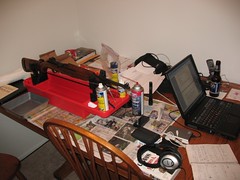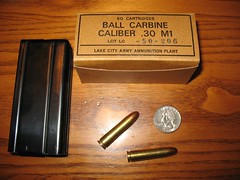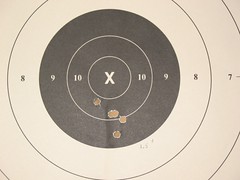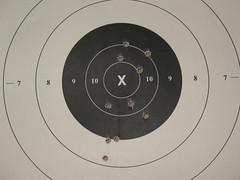A Day at the Range
Thursday 3 September 2008
2300
I am home on leave. Yesterday I realized a long-standing goal and finally made it to the rifle range. For a dyed-in-the-wool shooter and gun collector, going for two years without a rifle shooting session was torture! The last time I shot in the National Matches at Camp Perry was 2006. I missed 2007 and 2008, and it looks like now I’ll miss 2009 as well.
My stuff is in storage, but I had arranged it so that I can get into it and get out firearms, ammunition, and shooting accessories as needed. My earlier R&R leaves were just too short and packed full of obligations to take advantage of that, but this time I was determined to make the time to get in some shooting.
My desire to get to the range was increased by the fact that I’ve been acquiring new rifles while I was gone. The CMP got in a large consignment of M1 carbines (“U.S. Carbine, .30 Caliber, M1”) which were returned from the Italian government. The Carbinieri had been using these since just after WWII, and they finally armed themselves with modern rifles and returned these. As with other foreign military aid rifles returned to the U.S. Government, these were turned over to the Civilian Marksmanship Program for sale to qualified U.S. citizens. (For information on these programs, go to http://www.odcmp.com/ ).
I have had an ambition for many years to own a representative collection of carbines, hopefully at least one from every manufacturer. I put in my paperwork and was reasonably successful. As the different makes became available, I was able to get one of each except for the Saginaw S’G’, which is comparatively scarce. And I have not gotten an Irwin Pedersen, which is very scarce and only sold at auction. The prices on these have been a bit too rich for me.
But when I arrived home on leave I had eight boxes waiting for me, all unopened. Talk about feeling like a kid at Christmas! Here’s what I got:
Winchester
Rock-Ola
Saginaw Steering Gear
Underwood
IBM
Quality Hardware
National Postal Meter
Standard Products
I also got an Inland (produced by the Inland Manufacturing Division of General Motors), but it was shipped earlier and is already cleaned and stored. The Inlands were the most numerous and are thus the most common. They are also the only ones still offered for sale – the others are all sold out, and the CMP is not taking orders. I’m tempted to buy another Inland just for parts since the CMP is not selling spare parts… (is that a real reason or just a rationalization to buy another carbine?)
These carbines are in various states of cleanliness. All are “Service Grade”, which means they have no more than a specified amount of wear and tear on certain key parts. All were checked out by the CMP before being shipped, so they are complete and serviceable. But I found that while most of them are pretty clean and dry, a couple of them were still heavily coated with Cosmoline, a preservative grease that takes some serious effort to remove.
So the first thing I had to do was to go up and get out some cleaning equipment from storage, along with the ammunition and shooting equipment for the range. Part of the fun of getting these rifles is disassembling them to clean them and examining the various parts to see how original and “correct” they are. In one sense, they are all “correct”, because they are as-received directly from the government. But military armorers don’t always pay attention to which parts go with which gun. Add in the effects of repairs, rebuilds, and refinishing, and you mostly get what are known as “Mixmaster” rifles. None of them are exactly correct as they came from the manufacturer, but it’s still fun to see what you get.
I don’t have my reference books, so I can’t get into really detailed documentation of the parts – I just don’t know it well enough to know a Type I from a Type II trigger, sear, etc.. But I can examine and catalog the major parts, and leave the details until later. Cleaning them all is a big job, so I’m doing it a little at a time, and I just *had* to get out to the range before I was done.

Quality Hardware carbine in the cleaning rack
Originally uploaded by hkp7fan.

My Kitchen Table
Originally uploaded by hkp7fan.
There are two aspects to cleaning them. One is making sure that they are cleaned and lubricated to prevent deterioration (i.e. rust) when I put them in storage. Another is to make sure they are properly lubricated for shooting. The mechanism of these rifles requires special grease at certain points, just like the M1 Garand; otherwise they do not function reliably. I’ll end up cleaning each one at least twice: once initially and then again after shooting it. I’m determined to shoot all eight of them before I go back!
So far I have five cleaned, with three to go. For my day at the range, I took the Winchester (the M1 Carbine was a Winchester design, after all) and the Rock-Ola (there’s something cool about having a rifle made by a jukebox company!).

M1 Carbine - Winchester
Originally uploaded by hkp7fan.

M1 Carbine - Rock-Ola
Originally uploaded by hkp7fan.
I used standard U.S.G.I. .30 carbine ammo, headstamped LC 71 (Lake City Army Ammunition Plant, 1971 production). Even though I have reloading dies and have loaded .30 Carbine, I have a ton of this surplus stuff so I’ll shoot it first and save the reloading until after the U.S.G.I surplus is gone. As an aside, it *is* gone from the market – I bought the last two cases that the CMP had in stock back a few years ago. Now they only sell commercial ammo or sometimes imported military surplus ammo if they can get it. You might find some at gun shows, but as a practical matter, unless they discover some forgotten warehouse someplace, the U.S.G.I .30 Carbine ammo is gone.

M1 Carbine Ammo
Originally uploaded by hkp7fan.
First I went to the 25 yard range. This is really a pistol range, but when firing a rifle for which the zero is unknown, the first step is to get it “on paper”, then move to a more realistic rifle distance (in this case 100 yards).
I fired from the bench over a sandbag to give the best possible consistency so I could see how accurate the rifles are. I fired five rounds each at 25 yards, intending to adjust the windage as necessary. It turned out not to be necessary! Here are the results:

Winchester 25 yards
Originally uploaded by hkp7fan.

080903 Rock-Ola 25 yards
Originally uploaded by hkp7fan.
Considering that these were the first rifle shots I have fired in over two years (the last entry in my rifle field notebook was 5 August 2006), I was pleased. Especially when you consider that these rifles were all mass-produced between 1942 and 1944 and have seen many years of hard use, this is not too shabby at all.
After the 25 yard function and accuracy firing, I move to the 100 yard range to see how they did over a longer distance. I also fired from the bench over a sandbag rest. I had taken all my stuff along for position shooting (sling, shooting jacket, shooting glove, shooting mat) but I just didn’t feel like crawling into all that stuff on a hot day. So I contented myself with shooting two ten round strings from each rifle to see what I could do. The results weren’t too bad, especially considering that I did not have any 100 yard service rifle targets and had to use B8 25 yard pistol targets. Service rifle targets have larger bulls-eyes!
For the Winchester, I scored 82/100 with a 7” group, and then 89-3X/100 with an 8” group. Considering that my 49-year-old eyes can’t quite bring the front sight into crisp focus anymore (phooey!) I guess this is OK.

Winchester 100 yards
Originally uploaded by hkp7fan.
I did better with the Rock-Ola: 83-1X/100 with a 6” group, and then 95-1X/100 with a 5.5" group. Hooah!

Rock-Ola 100 yards
Originally uploaded by hkp7fan.
Whether this difference is due to the Rock-Ola carbine being in better condition or to me settling in and shooting better, I can’t say. I think I was pretty consistent, so we’ll give the credit to the rifle (that way if I do worse on the next one I’m allowed to blame the rifle…) ;-)
I noticed something interesting when I got these two rifles home and cleaned them. The Winchester had an Inland trigger housing, and the Rock-Ola had a Winchester trigger housing. I had already cataloged the parts for all the rifles I had cleaned, but since I did them one at a time over several days, I had not “put two and two together”.
I went ahead and swapped them, so that now my Winchester has almost all correct Winchester parts, and the Rock-Ola has the Inland trigger housing. Now, when I get my reference books out again, I may find that the WRA trigger housing was correct for Rock-Ola. In order to get finished rifles to the field as quickly as possible, the Ordnance Department had a system for moving parts between manufacturers. This has been fairly well documented in collector reference books, but I don’t remember all the details. For now, at least to the best of my knowledge, my Winchester is more correct than it was before, and the Rock-Ola is just as close to being correct as it was when I got it.
So much for my first day at the range in over two years! I have six more carbines to fire and report on, so I’ll be busy. Next time I’ll remember to take my camera with me and get some photos “in vivo”.
*Sigh*. Back home with my rifles - I’m like a pig in the proverbial…. :-)
Mood: Happy
Music: The Who – The Real Me

